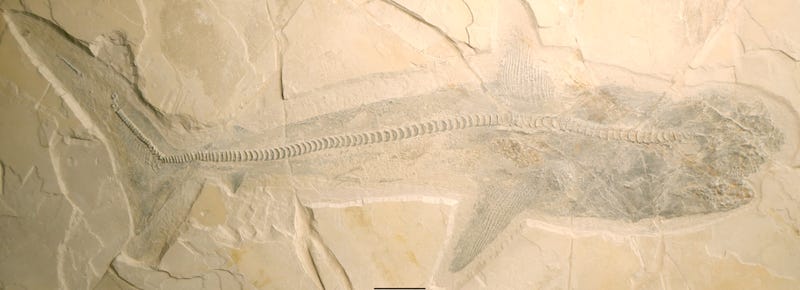The fossil shark Ptychodus was first identified 190 years ago, but in the intervening centuries of paleontological inquiry, a comprehensive look at the ancient fish has been hard to come by. Until now. In a paper published last week in the Proceedings of the Royal Society B, a team of researchers describe an exceptionally well-preserved Ptychodus, fossilized from its nose to the tip of its tail.
In their research, the paleontologists analyzed six near-complete Ptychodus specimens excavated from Vallecillo, Mexico, over the last decade. The specimens reveal the sharks’ skeletal components as well as their preserved body outlines. The team used the fossils to determine new information about the sharks’ anatomy and their place in the shark family tree.
“This new study provides crucial information on the affinities [evolutionary relations] and the paleoecology of Ptychodus,” said Romain Vullo, a paleontologist at the University of Rennes in France and lead author of the paper, in an email to Gizmodo. “So far, this Cretaceous shark was only known from isolated teeth, dentitions [sets of teeth], and a few skeletal elements such as vertebrae.”
“The complete specimens from Mexico reveal that Ptychodus was a fast-swimming open water shark (similar in shape to the living porbeagle), which likely used its grinding dentition to feed mostly on ammonites and sea turtles,” Vullo added.
In 2021, Vullo was the lead author on a paper describing Aquilolamna milarcae, a bizarre-looking Cretaceous era lamniform shark that was excavated from the same sweep of eastern Mexico. In the recent paper, the team also classified Ptychodus as a lamniform—a mackerel shark—and posit that the animal’s extinction may have occurred due to competition with mosasaurs, an extinct group of giant marine reptiles.
But the reality may be more complicated, as Tyler Greenfield, a paleontologist at the University of Wyoming, explained to Gizmodo. Instead of being a mackerel shark, Greenfield suggests Ptychodus belongs to an entirely different category.
 A well-preserved fossil of Ptychodus.
A well-preserved fossil of Ptychodus.
“Sharks of the order Lamniformes have specific patterns of the sizes and shapes of the teeth, the hollow sections in the jaws that hold the rows of teeth, and the cartilage structures inside the vertebrae that Ptychodus does not have,” Greenfield, who is not affiliated with the new paper, wrote in an email. “Those features were overlooked by the authors of the new paper and they instead used certain characteristics of the cranium and jaws, which are not unique to lamniforms, to classify Ptychodus.”
Greenfield added that, based on similarities between Ptychodus and both Squalicorax and Ptychocorax (two other species of ancient shark), the shark family including Ptychodus and the one including the latter two species ought to be placed in a separate order, Anacoraciformes, or crow sharks.
“Anacoraciformes was named by other authors before me, but it has not been used as valid since then nor has it included ptychodontids until now,” Greenfield said, adding that the teeth built for crushing shelled prey would likely have evolved outside of Lamniformes. “Overall, my hypothesis seeks to build a more accurate picture of the relationships and diversity of prehistoric sharks,” Greenfield said.
One might assume that such immaculately preserved fossils would settle aspects of the shark’s phylogeny, not complicate it. But regardless of how the dust settles regarding Ptychodus’ classification, it is refreshing—and indeed, incredibly fortunate—that paleontologists have such well-preserved specimens to use in making their determinations.
>>> Read full article>>>
Copyright for syndicated content belongs to the linked Source : Gizmodo (AU) – https://gizmodo.com.au/2024/05/paleontologists-disagree-about-what-this-exquisite-shark-fossil-actually-is/













![[News] Japan Develops 10nm Nanoimprint Technology, with Potential to Tackle EUV Bottleneck – TrendForce](https://earth-news.info/wp-content/uploads/2025/12/329851-news-japan-develops-10nm-nanoimprint-technology-with-potential-to-tackle-euv-bottleneck-trendforce-360x180.jpg)











![[News] Japan Develops 10nm Nanoimprint Technology, with Potential to Tackle EUV Bottleneck – TrendForce](https://earth-news.info/wp-content/uploads/2025/12/329851-news-japan-develops-10nm-nanoimprint-technology-with-potential-to-tackle-euv-bottleneck-trendforce-120x86.jpg)




